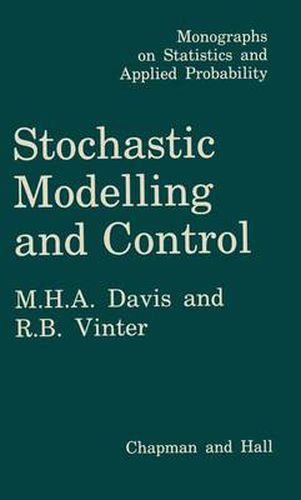Readings Newsletter
Become a Readings Member to make your shopping experience even easier.
Sign in or sign up for free!
You’re not far away from qualifying for FREE standard shipping within Australia
You’ve qualified for FREE standard shipping within Australia
The cart is loading…






This title is printed to order. This book may have been self-published. If so, we cannot guarantee the quality of the content. In the main most books will have gone through the editing process however some may not. We therefore suggest that you be aware of this before ordering this book. If in doubt check either the author or publisher’s details as we are unable to accept any returns unless they are faulty. Please contact us if you have any questions.
This book aims to provide a unified treatment of input/output modelling and of control for discrete-time dynamical systems subject to random disturbances. The results presented are of wide applica bility in control engineering, operations research, econometric modelling and many other areas. There are two distinct approaches to mathematical modelling of physical systems: a direct analysis of the physical mechanisms that comprise the process, or a ‘black box’ approach based on analysis of input/output data. The second approach is adopted here, although of course the properties ofthe models we study, which within the limits of linearity are very general, are also relevant to the behaviour of systems represented by such models, however they are arrived at. The type of system we are interested in is a discrete-time or sampled-data system where the relation between input and output is (at least approximately) linear and where additive random dis turbances are also present, so that the behaviour of the system must be investigated by statistical methods. After a preliminary chapter summarizing elements of probability and linear system theory, we introduce in Chapter 2 some general linear stochastic models, both in input/output and state-space form. Chapter 3 concerns filtering theory: estimation of the state of a dynamical system from noisy observations. As well as being an important topic in its own right, filtering theory provides the link, via the so-called innovations representation, between input/output models (as identified by data analysis) and state-space models, as required for much contemporary control theory.
$9.00 standard shipping within Australia
FREE standard shipping within Australia for orders over $100.00
Express & International shipping calculated at checkout
This title is printed to order. This book may have been self-published. If so, we cannot guarantee the quality of the content. In the main most books will have gone through the editing process however some may not. We therefore suggest that you be aware of this before ordering this book. If in doubt check either the author or publisher’s details as we are unable to accept any returns unless they are faulty. Please contact us if you have any questions.
This book aims to provide a unified treatment of input/output modelling and of control for discrete-time dynamical systems subject to random disturbances. The results presented are of wide applica bility in control engineering, operations research, econometric modelling and many other areas. There are two distinct approaches to mathematical modelling of physical systems: a direct analysis of the physical mechanisms that comprise the process, or a ‘black box’ approach based on analysis of input/output data. The second approach is adopted here, although of course the properties ofthe models we study, which within the limits of linearity are very general, are also relevant to the behaviour of systems represented by such models, however they are arrived at. The type of system we are interested in is a discrete-time or sampled-data system where the relation between input and output is (at least approximately) linear and where additive random dis turbances are also present, so that the behaviour of the system must be investigated by statistical methods. After a preliminary chapter summarizing elements of probability and linear system theory, we introduce in Chapter 2 some general linear stochastic models, both in input/output and state-space form. Chapter 3 concerns filtering theory: estimation of the state of a dynamical system from noisy observations. As well as being an important topic in its own right, filtering theory provides the link, via the so-called innovations representation, between input/output models (as identified by data analysis) and state-space models, as required for much contemporary control theory.